This is a Leica IIIg, a 35mm rangefinder camera produced by Ernst Leitz Wetzlar in Wetzlar, West Germany between the years 1957 and 1967. The IIIg was the last version of the original screw mount Leica to be released and was the successor to the IIIf adding several new features such as a self-timer, larger central viewfinder with projected framelines and automatic parallax correction. Other changes include a switch to modern shutter speed timings, a film reminder disc on the rear door, and a top 1/60 electronic flash sync. Attached to this camera is an Olympus 4cm f/2.8 Zuiko C LTM lens and 4cm auxiliary viewfinder. Not only was this the only LTM lens produced by Olympus, it was one of a very few with a 4cm focal length. The lens was only produced for a very short while and less than 2000 were thought to have been made.
Film Type: 135 (35mm)
Lens: 4cm f/2.8 Olympus Zuiko C. coated 5-elements in 4-groups
Lens Mount: M39 Leica Thread Mount
Focus: 3.5 feet to Infinity
Viewfinder: Separate Viewfinder and Coincident Image Coupled Rangefinder w/ Automatic Parallax Correction and Auxiliary 4cm Olympus Viewfinder
Shutter: Cloth Focal Plane
Speeds: T, B, 1 – 1/1000 seconds
Exposure Meter: None
Battery: None
Flash Mount: Cold shoe and M and X Flash Sync
Other Features: Self-Timer
Weight: 648 grams, 454 grams (body only)
Manual: https://www.cameramanuals.org/leica_pdf/leica_iiig.pdf
How these ratings work |
The Leica IIIg was the last iteration of Leitz’s original 35mm camera. It adds a couple of meaningful features to the original design, but otherwise is still faithful to screw mount Leicas that came before it. The larger viewfinder is a benefit to those wanting something larger, but still isn’t as large as 35mm rangefinders which were appearing on the market by other people. For anyone looking to complete their screw mount Leica collection, this is a must have, but I do not believe the upgrades it offers over the previous model aren’t worth enough to justify upgrading. | ||||||
| Images | Handling | Features | Viewfinder | Feel & Beauty | History | Age | |
| 2 | 2 | 1 | 1 | 2 | 1 | 30% | |
| Bonus | none | ||||||
| Final Score | 11.7 | ||||||
History
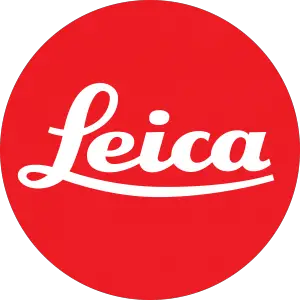 Waging a war on multiple other countries, invading territories which do not belong to you, and committing a large number of humanitarian atrocities comes with a price. In the case of post-WWII Germany, most people know that the country was split up into Allied controlled West Germany and Soviet controlled East Germany. Germany’s military was dismantled as was much of the production of pre-war industrial goods and products. In East Germany, the Soviet government seized control of Dresden area camera manufacturers such as Zeiss-Ikon taking their inventories and machinery as war reparations. For readers of this site, the assembly lines that produced the Zeiss-Ikon Contax rangefinder were shipped to Ukraine where the camera was relaunched and rebranded as the Kiev II and Kiev III rangefinder.
Waging a war on multiple other countries, invading territories which do not belong to you, and committing a large number of humanitarian atrocities comes with a price. In the case of post-WWII Germany, most people know that the country was split up into Allied controlled West Germany and Soviet controlled East Germany. Germany’s military was dismantled as was much of the production of pre-war industrial goods and products. In East Germany, the Soviet government seized control of Dresden area camera manufacturers such as Zeiss-Ikon taking their inventories and machinery as war reparations. For readers of this site, the assembly lines that produced the Zeiss-Ikon Contax rangefinder were shipped to Ukraine where the camera was relaunched and rebranded as the Kiev II and Kiev III rangefinder.
Although the sanctions and claim of reparations was not as severe in the West as it was in the East, West German companies were not completely spared of penalties. In the case of Ernst Leitz, they found that all pre-war patents and intellectual properties guaranteed to them by international law were null and void. This meant that any company who wanted to reproduce their version of a pre-war German product, was free to do so.
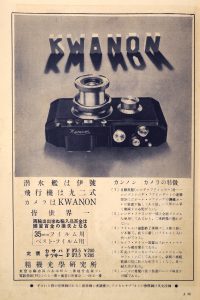
While copies of the Leica rangefinder were already being made in the Soviet Union, companies in other areas of the world respected pre-war German patents. This is why the Seiki Kogaku (Canon) Kwanon and Canon rangefinders did not use a 39mm Leica Screw Mount and had an overall different design. American companies like Clarus and Perfex who made screw mount 35mm rangefinder cameras used different size lens mounts like 40mm and others.
After the war however, it was open season on German patents. A huge number of Japanese companies, along with those from other countries began making Leica copies using the M39 Leica Thread Mount and with shutter and viewfinder designs nearly identical to the Leica, without any penalty.
For the first few years after the war, Leitz seemed content to keep building Leica cameras, even though they were no longer protected by their patents and many copies were being made. It would seem that western photographers were able to look past Germany’s war crimes when it came to buying commercial goods like cameras, as in those years, German cameras and lenses were still seen as the best in the world. Screw mount Leica rangefinders continued to receive incremental updates with models like the IIIf, IIf, and If from 1950, but these cameras were largely similar to their pre-war variants.
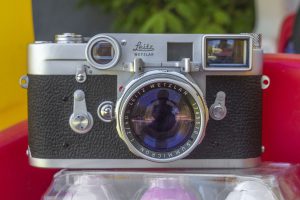
In late 1953 though, Leitz shocked the world with the release of an all new camera, the bayonet mount Leica M3. The Leica M3 continued in the tradition of world class quality and optics, but in an entirely new body, with new controls, new features, and an all new bayonet lens mount. With a new camera with new technologies, Ernst Leitz was able to regain control over their intellectual property and secure themselves from those who wanted to copy their newest design.
Although the Leica M3 was received very positively and sold well, it was very expensive and well outside of the budget of most average people, so the company continued to produce its screw mount cameras and lenses. Although by this time, Japanese Leica copies were gaining acceptance, to a large portion of the world, the original screw mount Leica was the best.
Despite having the world’s most advanced and best featured 35mm rangefinder in the Leica M3 (and follow-up M2 and M1 models), sales of the screw mount Leicas were still good enough that Ernst Leitz saw it fit to keep advancing the series with one more model. Work on a successor to the IIIf actually began during development of the Leica M3. In fact, at least one unnamed prototype of what would become the IIIg was produced in 1953 with serial number 650,003 exists and is currently in Wetzlar.
The 1953 Prototype has a much larger viewfinder, similar to the one that would be released on the final version in 1957, but added two additional features not found on the production version. The first was a built in automatic exposure counter which is designed very similarly to the one in the M3. Looking at images of the prototype, it looks fully functional, suggesting that perhaps this feature was intended all along, but scrapped later, possibly to keep costs down.
The second change was with a special 50mm f/3.5 Elmar lens which is seen on the prototype. Unlike any other 50/3.5 Elmar ever made, the diaphragm ring is much thicker and has f/stops engraved on a slanted ring at the back of the lens facing the body of the camera. These f/stop numbers we oriented in such a way that the user would be able to see them while looking through the viewfinder to know exactly which f/stop was being used.
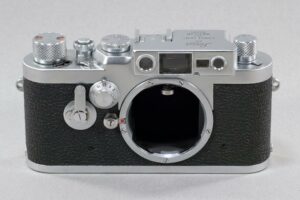
Like the production IIIg, the prototype had a self-timer up front, but differs in that the film reminder dial is still on the wind knob. According to Lars Netopil’s excellent Leica Prototype book, a bayonet mount version of the IIIg prototype was also made, but that version had no serial number.
It is clear that whatever changes needed to be made for a successor to the IIIf could have been made available pretty quickly but for reasons I was not able to discover, Leitz waited almost four years before releasing a production version of the IIIg in 1957. My best guess for why they waited was that Leitz probably concluded that by releasing an updated IIIg at the same time or very shortly after their new flagship M3, that consumers would likely be more attracted to the less expensive screw mount camera, hurting sales of the all new M3.
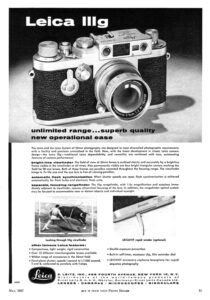
When the Leica IIIg made its debut in 1957, it was given the Leica catalog name of GOOEF and it omitted the prototype’s exposure counter, reverting back to a manually resetting version around the wind knob. The large optical viewfinder with projected frame lines for 50mm and 90mm which automatically correct for parallax was retained, as was the combined coincident image rangefinder and self-timer from previous models. An M3 style film reminder disc was placed on the back door of the camera instead of on top of the wind knob, and the progression of shutter speeds was also changed to match the M3. Gone were speeds like 1/40, 1/75, and 1/100, instead the shutter speeds progressed mathematically as was common of the era. In addition to new shutter speeds, two different flash sync positions were added, a black lightning bolt for X-sync at 1/50 and and red bolt for flashbulbs.
In addition to the new IIIg model, a scaled down version called the Ig was also available which replaced the If and like that camera, lacked any sort of viewfinder or rangefinder, instead relying on twin accessory shoes. The Ig also lacked the self-timer, but did feature a slow speed dial, allowing for a full selection of speeds from 1 to 1/1000. A super rare version of the Ig called the Ig Special was created which omitted the slow speed dial and both accessory shoes.
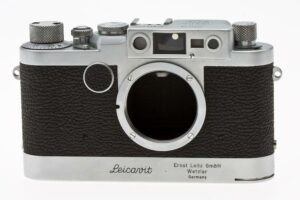
Unlike all previous Leica models, no version called the Leica IIg was ever put into production. Typically, Leicas with a roman number II before the model letter indicates a rangefinder camera with no slow speeds. A few Leica IIg prototypes were made, one of which, serial number 825,001 currently resides in the Leitz Museum in Wetzlar.
Nearly all Leica IIIgs were finished in chrome, but in 1960, a total of 125 cameras were finished in black enamel with a logo depicting three crowns on the rear of the camera for the Swedish army. In addition to the black enamel body, three lenses were finished in black as well, a 5cm f/2.8 Elmar, 3.5cm f/2.8 Summaron, and a 9cm f/2.8 Elmarit. Mechanically, the black cameras were identical to the chrome ones.
When the Leica IIIg first went on sale, prices for it were only $6 higher than the outgoing model. The camera could be bought body only for $186, with 5cm f/3.5 Elmar for $244.50 or with 5cm f/2 Summicron for $342. When adjusted for inflation, these prices compare to $2030, $2680, and $3750, which certainly were high, but not as aspirational as a Leica M3 which sold body only for $297 and with 5cm f/2 Summicron for $444.
The Leica IIIg was produced for a decade, ending production in 1967. Despite the 10 year production run a total of only 41,589 were produced, with a majority made before 1960, making them one of the less common Leicas ever made.
The Leica IIIg would be the final screw mount rangefinder model produced by Ernst Leitz as by the 1960s, the company was concentrating on their M-series rangefinders and preparing to enter the SLR market with their upcoming Leicaflex SLR. Around the same time Leitz exited the screw mount rangefinder market, most other screw mount copies did as well with Canon being one of the last to keep making such a camera, the Canon 7s, which was produced until 1968. After that, the only place where screw mount 35mm rangefinders were still being made was the Soviet Union who kept churning them out until the 1980s.
Today, there is no shortage of demand for Leica cameras. Whether you’re talking about the original Leica Model A from the 1920s to the latest M6 still being made today, Leica cameras are at the top of many collector’s wish lists. Of the screw mount models, the IIIg is certainly the most feature rich, but isn’t always on the top of best of list as some people feel it changed too much from the original design.
Regardless of whether you appreciate the advancements the IIIg offers, it is still a very good camera, made to the highest quality standards, and with support of the Leica Thread Mount, is compatible with literally millions of lenses made throughout the 20th and 21st centuries. If you are in the market for a screw mount Leica, the IIIg is an excellent choice!
My Thoughts
Everybody wants to be king. Sure, Canon, Nicca, Leotax and half a dozen other manufacturers made Leica copies or clones that were pretty good, and take just as good of photos as a genuine Leica, but there’s something about having the real thing, the OG, the one and only Leica.
If you were to buy a Leica, you have a lot of options. There are no less than a dozen models in each of two broad categories of screw mount and bayonet mount Leicas. Screw mount Leicas are more plentiful and less costly, but older and more primitive. But lets say your budget will only afford you a screw mount Leica, but want the “best” screw mount Leica, which one to get?
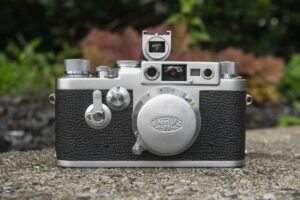
If by “best” you actually mean the newest or the one with the most features, then that’s easy, the Leica IIIg was the last of the original screw mount cameras, so therefore the newest, but it also has features that no other screw mount Leica has. So of course, it must be the best, right? Well, maybe.
Something that has been true ever since the release of the original Leica Model A in the mid 1920s was that each new model Leica was always an evolution of a previous model, incrementing the previous design with minor changes. In the instance where an entirely new feature was added, it was almost always incorporated into an existing design so that users wouldn’t have to adjust to an entirely different camera just for the benefit of something new.
This dedication to evolution, rather than revolution applies to the Leica IIIg as the camera is more like the previous IIIf than it is different. Body size and shape are unchanged, as is the lens mount and loading film. Although the M3 and some prototypes of screw mount Leicas featured a hinged door in the back of the camera to inspect the shutter and aide in film loading, the IIIg is still a pure-bottom loader. Even the self-timer which is not found on most screw mount Leicas is actually not unique to this model as some versions of the IIIf had one too. Externally, the two biggest changes are the much larger viewfinder and relocated film reminder dial to the back of the camera.
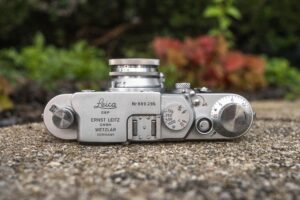
Up top, the Leica IIIg bears strong resemblance to previous screw mount Leicas. From left to right is the rewind knob with adjustable diopter lever beneath. In the center is an accessory shoe, and to its right is the single piece shutter speed dial with speeds from 1/30 to 1/1000, plus options for Bulb and two flash sync settings for X-sync which is 1/50 and flashbulbs. The slowest speed is labeled 1-30 and when set uses the slow speed governor on the front of the camera to choose slower speeds from 1 to 1/30 plus T. As is the case with all screw mount Leicas, the shutter speed dial rotates as you fire the shutter, so care must be taken to not let it drag against your finger as it will interfere with the curtains causing problems with exposure. Lastly, you should only change shutter speeds after the shutter is cocked, as your chosen speed will not line up with the black arrow on the accessory shoe unless the shutter is cocked.

On the lower part of the top plate is the shutter release with a removable shroud around it. Screw mount Leicas do not use the traditional threaded cable release socket. Instead, the shutter release is externally threaded around its perimeter for what is known as a “Leica-style” cable release. You must first remove this shroud first, before attaching it. Above the shutter release is the film transport lever which moves between A and R for Advance and Rewind. Finally, on the far right is the combined film advance knob and exposure counter. Unlike the Leica IIIg prototype from 1953 which had an automatic exposure counter, the one on the production version is completely manual, just like every screw mount Leica that came before it.
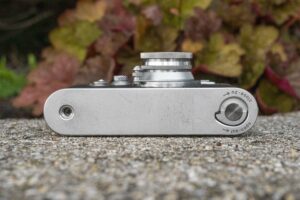
Like the top, the base of the IIIg looks like previous Leicas, which is to say, pretty barren. Save for 1/4″ tripod socket on one side and the lock for the film compartment on the other, there’s nothing to see here. That the Leica IIIg still supported reusable metal film canisters was likely a plus to long time Leica users, but by the late 1950s when this camera made its debut, less and less people were using them.
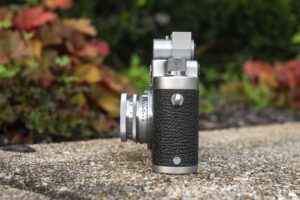
As a bottom loader, that means there are no hinges on the sides of the body, just a rounded edge that is very comfortable in the hand. On both sides of the IIIg are metal strap lugs which is a feature not consistently found on Leica copies. Although the IIIg is relatively small and compact, it is nice to have the option to attach a strap without having to rely on a leather case.
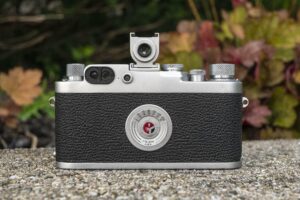
Around back, the biggest change is the relocated film reminder dial which is nearly identical to the one on the back of the M3. Since the IIIg has no meter, this dial service no other purpose than to remind you of what film is loaded in the camera, but it does look pretty. The only other difference you’ll notice is a slightly taller top plate and that the opening for the viewfinder is a tad larger than before.

The Leica IIIg is a bottom loader, which if you know anything about these cameras is that this is one of the most contentious aspects of this and many cameras that copied it. If you’ve never used a bottom loader camera before, trust me when I say this, it is not as bad as many people make it seem. There are many video walkthroughs online showing you how it done, but the key to all of them is that you need to cut the film leader to make the narrower part longer than you will see on a modern roll of 35mm film. Years ago, 35mm film came with longer leaders, but today, the leader is too short, so you must make it longer.
There are many options for doing this, but the easiest is just to use a pair of scissors. Your cut doesn’t have to be perfect, just extend the narrow part of the leader so that it is at least as long as the distance from the take up to the supply spool of the camera and that’s it. A diagram inside the camera says the leader must be 10 cm or 4″, but that is just the minimum length, it does not have to be exact.
After cutting the leader, remove the take up spool, attach the leader, and then slide both the take up spool and supply cassette into the camera at the same time. That’s all there is to it. If this is your first time, I strongly recommend getting a test roll of film to try it out on for practice, but after trying it a couple of times, anyone should be able to load film into a bottom loading Leica with ease.

The Leica IIIg uses the venerable 39mm Leica Thread Mount which means it supports a huge number of German, Japanese, and lenses made in other countries. In addition to being more affordable than the Leica M3 which was released prior to this camera, maintaining this backwards compatibility would have been the one of the IIIg’s key selling points. Removing the lens is as easy as rotating counterclockwise to remove and clockwise to attach.
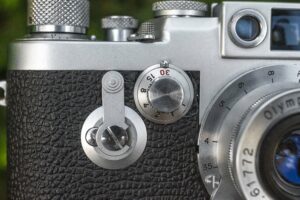
To the left of the lens mount is the self-timer, also known as the delayed action timer. In order to use the timer, you must rotate it a full 180 degrees from its starting position until it locks into place. Attempting to only partially rotate the knob won’t lock it into position, giving you a shorter delay, which if that’s what you want, does technically work. Once the timer is set and in its locked position, it will stay like this until you press a small chrome button to the left of the lever. Pressing the top plate shutter release does not activate the timer. If you wind the self-timer and then decide later you don’t wish to use it, you can cancel it by pressing this button without the shutter cocked and it will just wind down without firing the shutter.
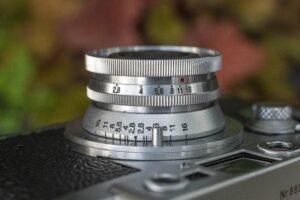
The Olympus Zuiko 4cm f/2.8 lens is very compact and to someone who is not familiar with it, could mistake it for a collapsible lens, but it does not collapse or extend. How you see it in the image to the left is how it remains while shooting. While it is convenient for portability, it does result in focus and aperture rings which are quite narrow and somewhat difficult to locate with the camera to your eye. Like most Leica Thread Mount lenses, the focus scale is seen off to the left. A depth of field scale is engraved into the lens, as are aperture stops from f/2.8 to f/22.
The viewfinder is where the biggest change to the Leica IIIg is from all previous models, but I’ll get to that in a second. On the left is a dedicated rangefinder window. Ever since the first Leica Model D rangefinder, the rangefinder and viewfinder windows have been separate. Although this is seen as a ‘con’ to some photographers as it requires you to move your eye between two locations, in reality, it is an advantage as it allows the rangefinder window to have a different magnification than the main viewfinder window. This allows for much greater accuracy, especially when using lenses longer than 50mm as the split image is magnified, giving you greater precision. Further precision can be obtained via a lever beneath the rewind knob which acts as a diopter for the rangefinder window, allowing you precise control over how sharp everything is in this window.

The main viewfinder is much larger than on any previous screw mount Leica. Inside is a rectangular frame that depicts a 50 mm image. Inside the square are four notches indicating the corners of a 90 mm image. This is the first Leica ever to have a built in viewfinder for 90 mm lenses. The two sets of frame lines automatically correct for parallax so when you focus the lens down to minimum focus, you’ll see them shift towards the bottom. Since the rangefinder is in a separate window, there is nothing else to see in this window and since the viewfinder doesn’t need to use a beamsplitter, it is very bright and shows good contrast.
While a larger viewfinder is almost always a good thing, I was disappointed that it is not any more useful while wearing prescription glasses than the smaller window on earlier Leicas. With my face pressed as close to the camera as I can get without scratching my lenses, I can only barely make out the four notches for the 90 mm image. I cannot see the 50mm frame lines at all, without either removing my glasses or shifting the camera from side to side. For those with good vision, I suspect the larger viewfinder is a nice benefit, but for people like me, you’re stuck with having to guess at your composition or using an auxiliary viewfinder.
Whether or not you think the upgrades to the IIIg are worth it over previous Leicas, this is still a Leica. It is built to the highest quality standards, is compatible with a huge selection of some of the best lenses ever made, and if taken care of, can provide a lifetime of quality use. I probably don’t need to say this, but if you want to see some sample images and hear my final thoughts, keep reading to the next section.
My Results
Shortly after acquiring the Leica IIIg, I took a family trip to Minnesota and it seemed like an ideal location to test it out. Although I did have a couple 50mm Leitz lenses that I could have used with the camera, the 40mm focal length is my favorite as my “mind’s eye” naturally sees that focal length better, so having never shot an Olympus LTM lens, I mounted it and the Olympus viewfinder to the camera, loaded in some fresh Fuji 200 and packed it in my bag.
Normally when shooting interchangeable lens cameras, I say that the images are more about the lens than the camera itself which is especially true here where I used a pretty uncommon lens. There might be those who are frustrated at my use of a non Leica lens on a Leica camera, but rest assured, had I used an Elmar, Summitar, or any other number of screw mount Leitz lenses, my opinion of the camera would not have changed.
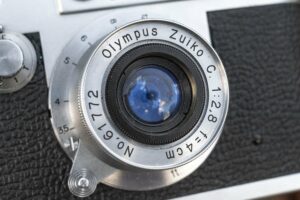
The 4cm Olympus Zuiko lens, unsurprisingly, returned spectacular images as do pretty much every other Olympus Zuiko lenses ever made. Where this lens especially shined for me was its slightly wider 4cm focal length compared to the 5cm lenses usually found on these cameras. Whenever I am about to take a photography, I first compose the image in my head before making it with the camera, and I often find 5cm or 50mm lenses to be a tad too tight for the style of photography that comes naturally to me. This has resulted in a preference for 35mm and 40mm lenses to be my “preferred focal length”. While there are a large number of 3.5cm options I could have chosen, to shoot a 4cm lens was one I didn’t want to pass up.
The 4-element Zuiko lens produced images with excellent sharpness, corner to corner with no noticeable softness or vignetting near the edges. Color reproduction was accurate and showed good contrast on the Fuji 200 I used in the camera. One characteristic of this lens is that it has a very wide depth of field. While I wouldn’t go as far as to say this lens could be used focus free, at distances over 10 feet away, focusing with the rangefinder was not necessary. This is a lens in which you can just set the distance to just under infinity, stop down the lens to f/11 and exclusively use the Olympus 4cm auxiliary viewfinder, making shooting it very quick.
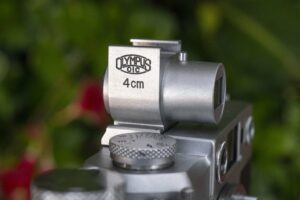
While shooting the Leica IIIg with the Olympus 4cm lens, it was not lost on me that I wasn’t using the most significant upgrade of the camera since I composed my image with the auxiliary viewfinder. That I wasn’t using the built in viewfinder with its 5cm frame lines turned out to be a blessing for me as I couldn’t see the frame lines while wearing prescription glasses. In testing the camera, looking through the much larger viewfinder, I was a bit disappointed that the experience wasn’t better. Certainly those with better vision (or contact lenses) wouldn’t have this problem, but as a glasses wearer, I felt the Leica IIIg didn’t really improve by a measurable amount over previous screw mount Leicas.
I don’t know that I would call the viewfinder a complaint, rather, more of a disappointment but with that disappointment out of the way, the rest of the experience was excellent. That this was one of the cleanest screw mount Leicas I’ve ever handled meant that the camera performed almost as if it was new. I don’t know the history of this particular example, but it would not surprise me if it hadn’t had a CLA at some point recently, it was that smooth.
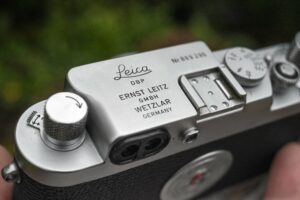
The rest of the shooting experience was like you’d expect. Leitz didn’t change all that much from earlier Leica IIIs, whether it was the IIIf or the IIIa. Loading the film was mostly the same, film advance was mostly the same, changing shutter speeds was mostly the same, even the Olympus lens worked pretty much like any other Leitz lens I’ve handled.
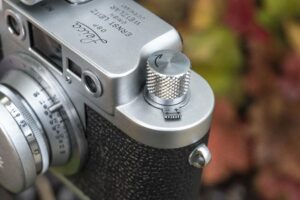
Overall, the Leica IIIg is a fine shooting instrument and one I am glad I had the chance to shoot. If you are a current owner of an earlier Leica and have always wondered if the IIIg is worth upgrading to, my answer is not really. Unless you REALLY like self timers, a larger film reminder dial, or a viewfinder that is only useful if you don’t wear glasses, there simply isn’t enough new to warrant spending the money these go for. If however, you are looking to get into this style of camera, the IIIg does nothing to take away from the experience and is just as pleasant to use and capable as any earlier model.
So there ya go, the Leica IIIg is a fine camera. It was an incremental upgrade from the previous model, but doesn’t change enough that I feel is worth the money to upgrade. If you are looking for your first screw mount Leica, and you can find one for a reasonable price, by all means, go for it, just don’t expect to be wowed in ways that earlier Leicas wouldn’t also wow you.
Related Posts You Might Enjoy
External Links
http://camera-wiki.org/wiki/Leica_IIIg
https://vintage-photo.nl/leica-iiig-review/
https://aboutphotography-tomgrill.blogspot.com/2015/06/legends-leica-iiig-pinnacle-of-design.html
https://alondoninheritance.com/london-photography/london-leica-first-light/
https://rangefinderchronicles.blogspot.com/2012/12/leica-iiig-50mm-summarit-f15-first-roll.html


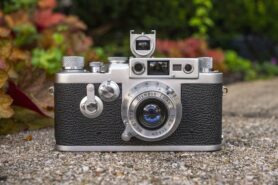
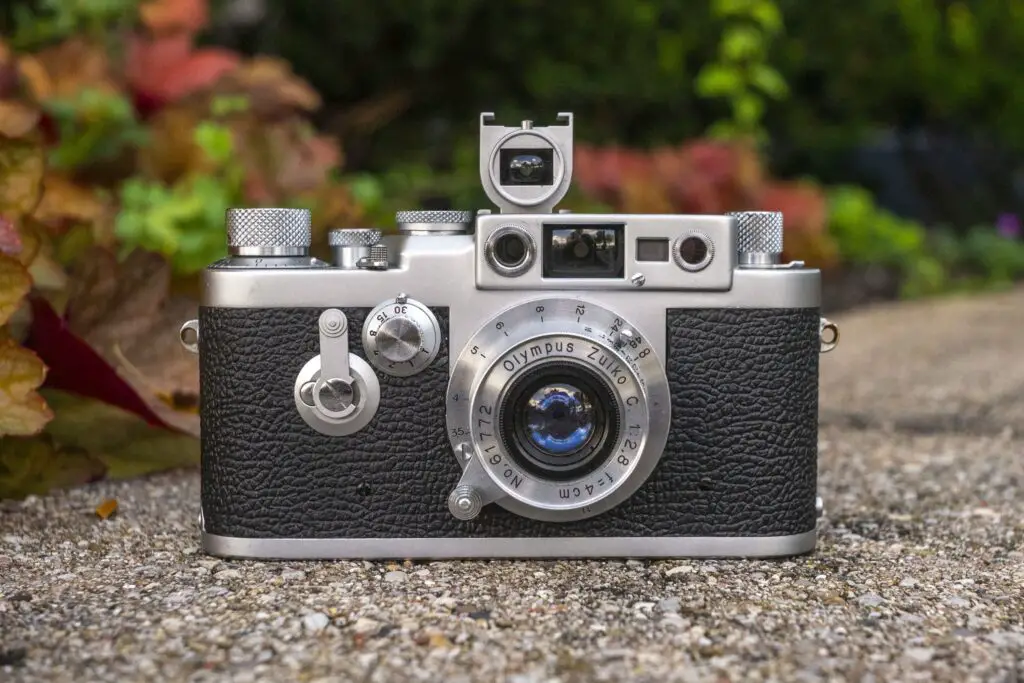

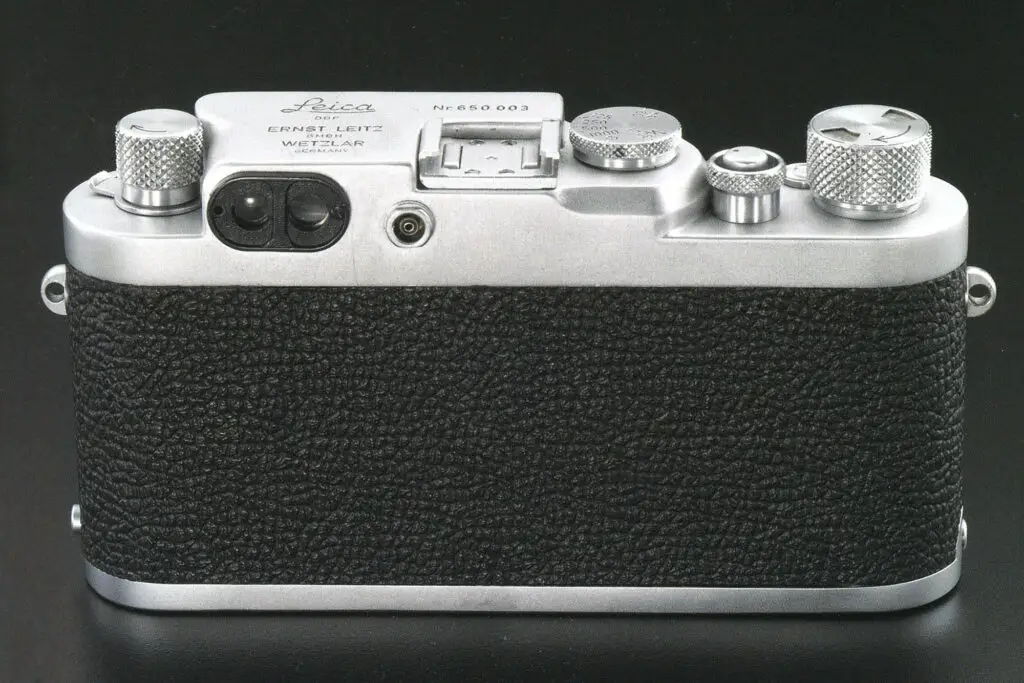
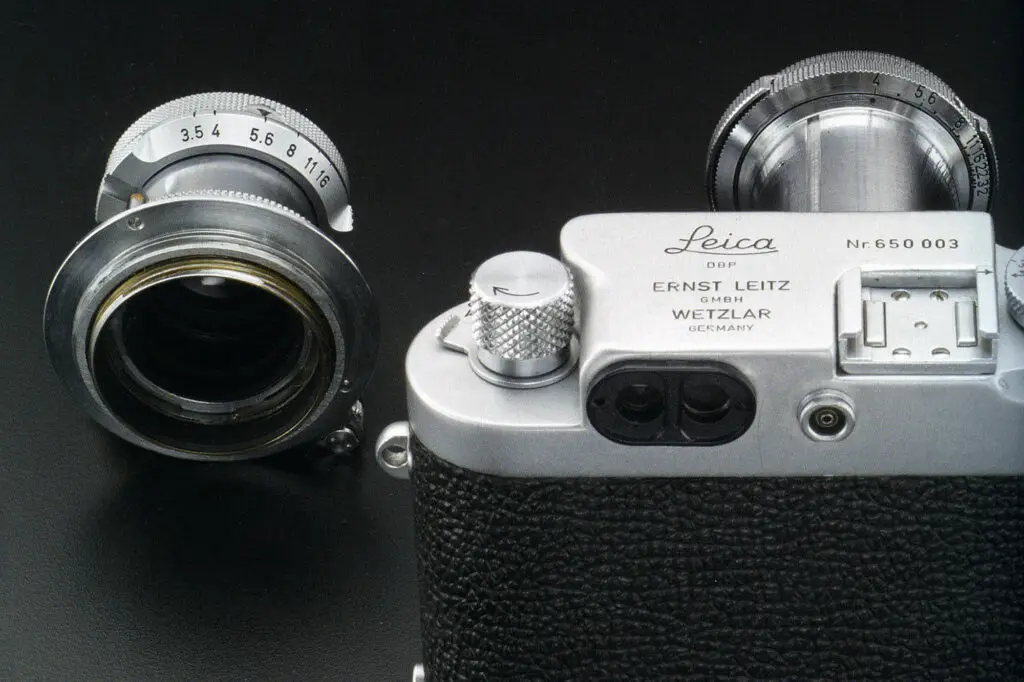
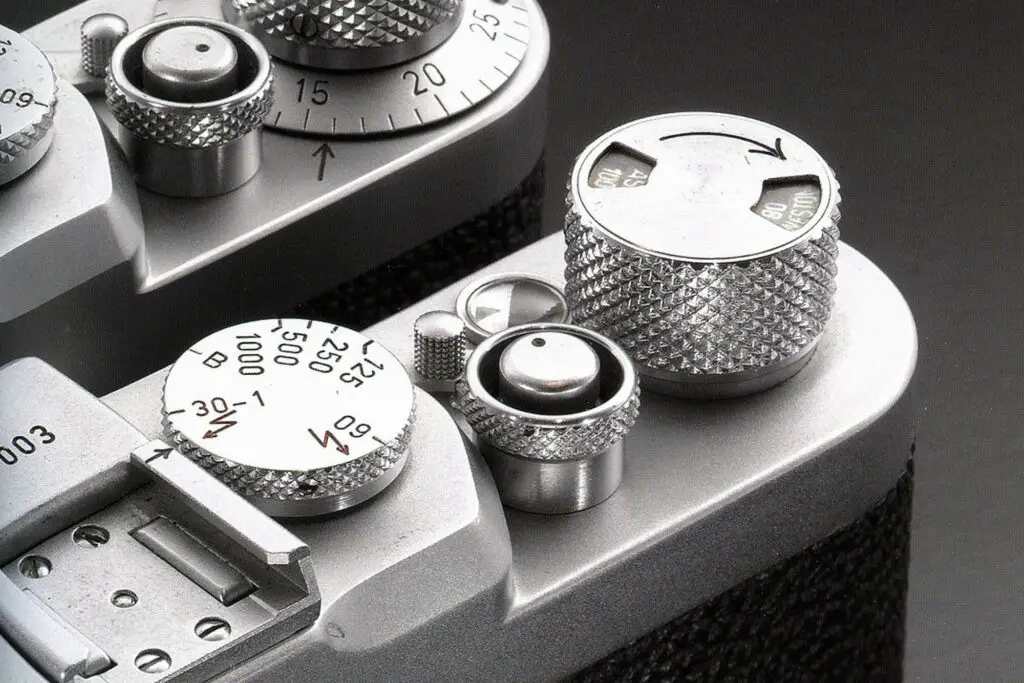






















One of the things about your posts I like is that it’s not just about the performance of the item in the headline title but often the social /world history at the time and how this came to bear on the design of a specific camera or lens.
For instance I knew about authorised and Soviet copies of Leica designs and the wholesale relocation of Contax production, but not about the loss of patent rights and how that was exploited.
And of course reading your posts can often enable one to see how subleties of design were introduced – and of course it’s a chance to look at great cameras!
I have a Leica IIIf and an M3, they spend almost all of their time on the shelf. I bought the Leica IIIf almost 20 years ago as a replacement for a camera I had used (it was my Dad’s) as a teenager. I thought it would be nice to have the camera as it is reputed to be “the best”. Dad also had at one time a Ried III with Taylor Hobson 50mm f2 – he sold it to by the IIIf as “it wasn’t a Leica” wish he’d kept it, it would be worth much more than the Leica today.
I used the Leica IIIf a couple of times but was unimpressed with the results using Summicron f2 and Summitar f2 collapsible lenses, so it languished on the shelf. I got better pictures with my Olympus OM-1 camera and Zuiko lenses. It remained on the shelf until a couple of years ago when I thought that as it was approaching 60 years old I would give the IIIf a CLA, and since I was living in Hamburg I would send it to Wetzlar for the overhaul. Understand that the camera was working correctly the shutter speeds were fairly accurate and the lens was clean, albeit with a sloppy aperture ring.
So it went to Wetzlar and I waited for its return……and waited …and waited. after 3 months it was returned to me. I shot a roll of film with it only to discover that there were now pinholes in the shutter, and the aperture ring by the end of the first roll had resumed its sloppy feel.
It was returned to Wetzlar for repair and I waited another 2 months for it to be returned. When I got it back it was working correctly and the shutter had been replaced again, the lens was still sloppy. I shot one more roll of film with it and put it back on the shelf where it has been ever since.
I paid more for the service than I had paid for the camera and lens.
My M3 works ok and after the experience with the IIIf I will not bother to send it for CLA. It, too, sits unused gathering dust on the shelf. I only keep them for sentimental reasons and would never use them for any serious photography, for that I have Olympus film cameras and lenses.
Leica? like Apple, over hyped and over priced.
I get what you’re saying. For serious photography an SLR or even DSLR does the work better.
I shoot digital, but I have a film camera with me for fun. I like that I take a picture and have to wait for the result, and have to try to improve on a next trip. I have a IIIa from 1936 with a collapsible Summar, and it’s not the sharpest tool in the shed to say the least, however I like the look it produces. The same applies for my M2 with a Summicron lens and Contax IIa with a Sonnar lens. I can understand that not everyone would like the look of it.
It’s also difficult to compare 50’s single coating optical technology with the 70’s multi-coating and computer calculated optical formulas. I would suggest to get some cheap Fomapan and shoot the Leica’s more often. Sitting on the shelf and gathering dust is a camera’s worst enemy. The shutter needs to work every now and then. And who knows, perhaps you will grow to like the look of the lenses for less serious work.
So are they over hyped? Of course. Are the over priced? For sure. Especially compared to a Canon EOS 300.
Are they nice? Definitely, if Leicas were 10 times cheaper I would own more of them 😉
I have a IIIf and a IIIg. I bought the IIIf first and then the IIIg. When I got the IIIg, I thought I would be able to sell the IIIf since I now had the upgraded version, but for some reason I couldn’t. I like the smallness of the IIIf when compared to my IIIg, and the exact f camera I have is definitely quieter. I don’t regret my IIIg purchase at all, and when I do talk to some dealers, they often said “great camera.” I think there is space for both in a collection because of the size. If you’re committed to the LTM, then the more pocket -friendly IIIf makes a great “second body” that modern SLR shooters swear by when in the field. For my photography practice, I like having two cameras so I can have color and b&w film. Having two bodies also means that I don’t have to fumble with removing a lens. So I agree with you Mike, but with the IIIf going for under $200 in some places, I like to compare the pricier IIIg to having a Nikon F2 or F3 in the day, and the IIIf as your FE2 or FM2 second-body option. Love the review and podcast!
Very well done as always. One small point. The iiig was released in 1956 with SN 825001. The earliest 1957 serial number is 858001.
Test
Anyone truly desiring a “state of the rangefinder art” LTM39 camera body should purchase a Canon 7SZ. It loads properly (with a rear film door); it has a combined RF/VF in a single window, it has multiple frame lines for all common focal length lenses; it has lever advance; and it’s built like a tank.